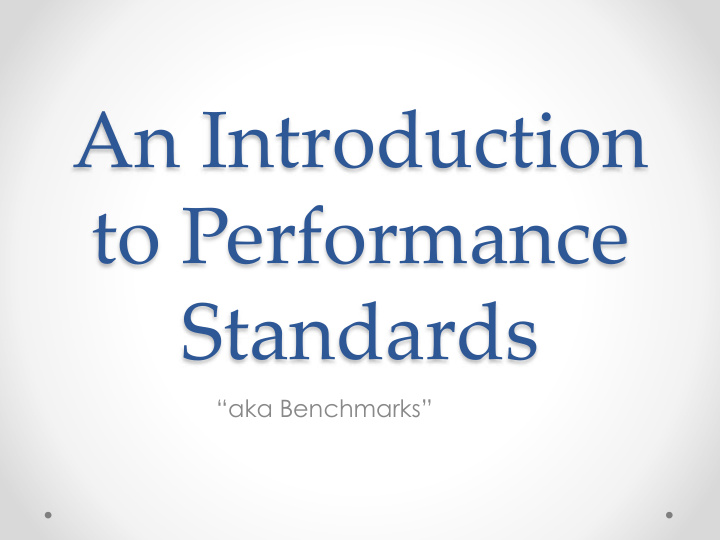



An Introduction to Performance Standards “aka Benchmarks”
Mary Jane K. DiMattio, PhD, RN 2017 Intersession Assessment Institute
Learning Outcomes • At the conclusion of today’s presentation, the participant will: o Define local benchmarks. o Discern the appropriate use of grades in setting local benchmarks. o Describe at least two strategies for setting specific and appropriate local benchmarks. o Explain how benchmarks are used.
Types of Benchmarks or Standards • Suskie (2009) identifies 10 types of benchmarks or standards. • Today’s presentation will focus on local benchmarks. • Also known as competency-based or criterion- referenced standards, local benchmarks tell us whether or not students are meeting our own expectations.
Local Benchmarks Advantages • Faculty ownership • Employers, legislators, and other stakeholders tend to support these standards Potential Pitfalls • Need to be clearly defensible
Is this Benchmark Defensible? Why or Why Not? N 593 Research • Methodology SLO: The graduate • student will articulate a comprehensive overview of the research process in nursing. Artifact: Quizzes • Benchmark: All of the • students will achieve a grade of B- or better on every quiz.
Is this Benchmark Defensible? Why or Why Not? • N 593 Research Methodology • SLO: The graduate student will critique qualitative and quantitative research. • Benchmark: 80% of students will attain a grade of B or better on the research critique assignment.
Specific and Appropriate Local Benchmarks • Consider the implications of your decisions. Take context into account. o Ask yourself if the benchmark is too high or too low. o Benchmarks should be challenging but attainable (AACSB, 2013). o How high are the stakes? o • Is it acceptable if only 80% of accounting majors can correctly file a tax return? • Is it acceptable if only 80% of nursing majors can calculate medication doses? Consider the “embarrassment factor” ( Suskie, 2015a). o
Specific and Appropriate Local Benchmarks • Know how the results will be used. o Improvement vs. status quo • If improvement, then incremental benchmarks will be necessary • If status quo, then a lower benchmark is likely indicated • Do some research. o Bring in external information o Look for disciplinary standards • Disciplinary organizations • Peer programs
Specific and Appropriate Local Benchmarks • Involve others in the process. o We have to talk to each other! • Use samples of prior student work • Consider rubric criteria instead of grades. o Minimum standard for every trait o Minimum standard for the sum of all traits o Minimum standard for certain traits • Revisit and refine benchmarks on a cycle.
Use Benchmark Results to Close the Loop! • If students do not consistently meet the benchmark, then curricular or pedagogical changes may be warranted.
References AACSB (2013). White paper on assurance of learning standards. • Retrieved from http://www.aacsb.edu/~/media/AACSB/Publications/white- papers/wp-assurance-of-learning-standards.ashx Suskie, L. (2009). Assessing student learning: A common sense guide • (2 nd ed.). San Francisco: John Wiley and Sons. L. Suskie (2015 a, March 23). Setting meaningful benchmarks or • standards [ Web log post]. Retrieved fromhttp://www.lindasuskie.com/apps/blog/show/43191428-setting- meaningful-benchmarks-or-standards Suskie, L. (2015 b, November 6). Linda Suskie at University of Dayton • [ Video file] . Retrieved fromhttps://www.youtube.com/watch?v=1y860yBacpo •
Recommend
More recommend